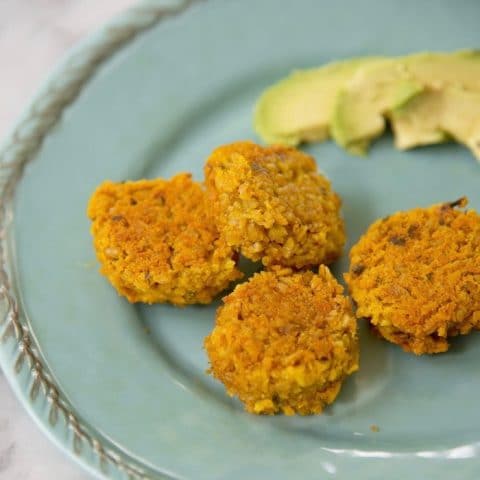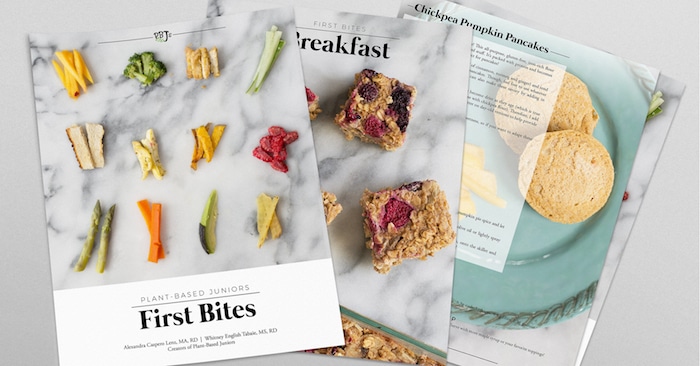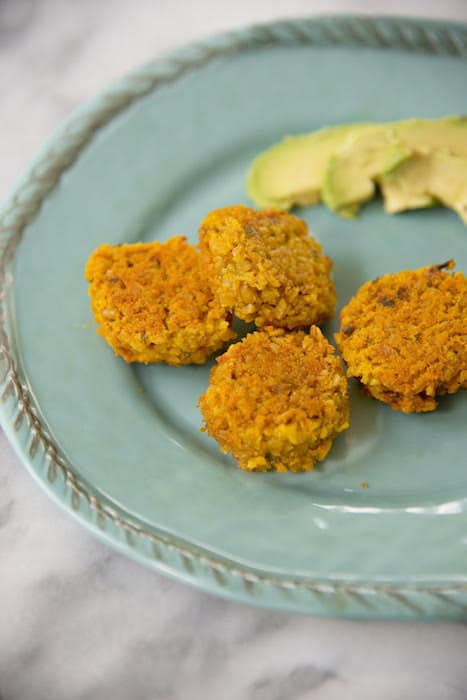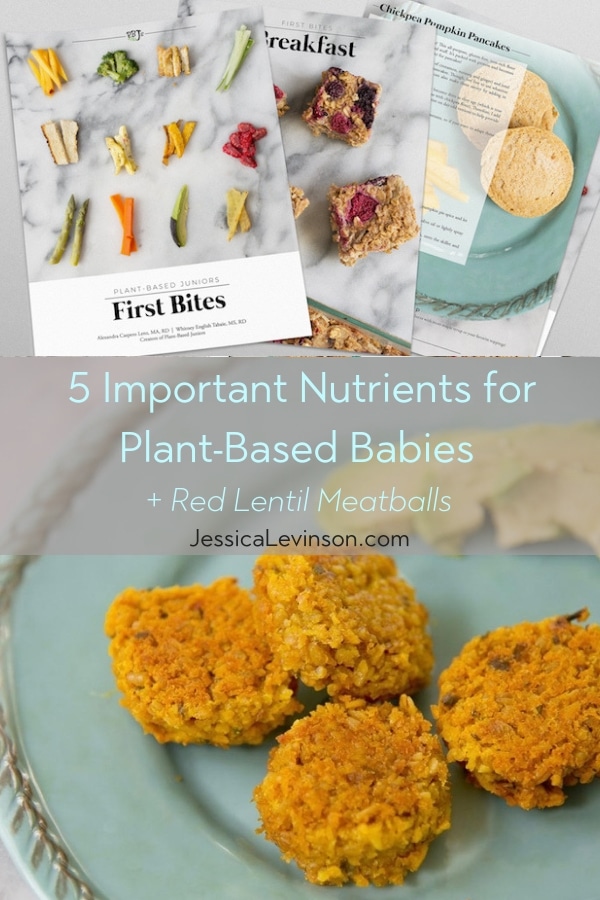5 Important Nutrients for Plant-Based Babes + Red Lentil Meatballs
Pin this Post
Following a plant-based diet? Make sure your kids get the nutrients they need. Here are 5 important nutrients for plant-based babies, plus a delicious baby-friendly recipe for red lentil meatballs.
This page contains affiliate links. See below for full disclosure statement.
This is a guest post by Whitney English Tabaie MS, RDN and Alexandra Caspero MA, RDN, the creators of Plant-Based Juniors, and authors of the new e-book PBJs: First Bites, the definitive guide to baby-led weaning for plant-based babies.
While my family does not solely eat a plant-based diet (and my kids are well past the baby feeding stage), we do try to incorporate as many plant-based meals as possible, and I think this is a great resource if you’re looking to mix in plant-based foods or if your family is completely plant-based.
5 Important Nutrients for Plant-Based Babes
by Whitney English Tabaie MS, RDN and Alexandra Caspero MA, RDN
Plant-based eating is on the rise! With the popularity of documentaries like What the Health and products like the Impossible Burger, this fruit and veggie-heavy eating pattern is becoming increasingly popular – and for good reason. Research shows plant-based dietary patterns may decrease the risk of chronic diseases like diabetes, cancer, and heart disease and increase lifespan.
But while adults may be eager to start eating a more plant-based diet, many parents may wonder if they’re safe for kids?
As the creators of Plant-Based Juniors, we’re here to ease your fears! Plant-based diets – whether vegan, vegetarian, or predominantly plant-based, are perfectly healthy for kids. As long as parents make sure their babes get enough of certain key nutrients, kids can absolutely thrive on plant-based diets.
In our new ebook, PBJs: First Bites, we outline everything you need to know about plant-based nutrition for kids and include 20 delicious recipes that incorporate these nutrients of concern using an approach known as “baby-led weaning” (BLW). BLW introduces infants to solid foods without the use of purees. Research shows it may help kids form a healthier relationship with food than a more traditional approach.
Whether or not you choose to do BLW or go fully plant-based, you’ll still want to make sure your little one is getting the nutrients they need. Here’s a primer from our book on five nutrients that parents should aim to optimize in their children’s diets.
5 Important Nutrients For Plant-Based Babies
1. Iron
Iron is an extremely important nutrient for kids. It’s a main component of red blood cells, which are responsible for carrying oxygen to the cells. It’s also involved in energy production and immune function. Babies who are iron-deficient may end up with slow weight gain, pale skin, low appetite and irritability.
Infants accumulate iron in utero, but by six months, breastfed babies need to start getting it from food.
While plants have plenty of iron, the type of iron found in plants isn’t as bioavailable as that found in meat, therefore vegans and vegetarians need to eat a little more than meat-eaters. They should also aim to consume iron-rich foods with a source of vitamin C, which can boost absorption by 5 to 6 times!
Good sources of iron include whole grains, legumes, nuts, and seeds. Pair them with citrus, strawberries, or bell peppers to reap those absorption benefits!
2. Vitamin B12
B12 is needed for hundreds of reactions in the body: it’s important in cell division, the formation of healthy red blood cells, and needed to produce myelin, the protective sheath around nerve fibers. Considering the importance of new nerves and red blood cells for all of us, but especially during periods of rapid growth, it’s essential to have a source of B12 in your plant-based baby’s diet.
You may have read that some vegan foods, like fermented soy foods, tofu, sourdough bread, and sea vegetables, contain B12. They do not. They contain inactive analogues, which are similar to B12 but don’t have the vitamin activity that we need. Only animal products contain B12, therefore, breastfeeding mothers who are vegan or don’t consume enough animal foods or fortified products should supplement B12.
Strict plant-based children can get their B12 from fortified foods like plant-milk or nutritional yeast, or take a daily supplement.
3. Vitamin D
Vitamin D is needed for proper bone formation, which is critical during childhood. Children with vitamin D deficiency can develop a condition known as rickets, which causes “soft bones” and skeletal deformities.
Vitamin D is only found naturally in a few foods including salmon and eggs. The good news is that you don’t need to eat anything to get vitamin D. Your skin produces it from sunlight! The bad news is that because of our increased use of sunscreen, many people (and kids) aren’t making enough of it.
The AAP recommends that breastfed babies receive a supplement of 400 IU of vitamin D daily starting at birth. Plant-based children should continue to supplement if they don’t get daily sunlight exposure and aren’t consuming adequate amounts of foods containing vitamin D.
4. Calcium
The biggest myth about plant-based nutrition for kids is that they need to drink milk to get adequate calcium. Calcium is found in all kinds of plant foods including cruciferous veggies, soy products, fortified plant milks, and legumes.
Breast milk and formula provide enough calcium for kids until 1 year of age. At one year, calcium needs triple, which is why doctors recommend children begin consuming cow’s milk at this time. If your child isn’t eating dairy however, a fortified beverage like soy milk is a nutritionally equivalent replacement.
5. Omega-3 Fatty Acids
Omega-3 fatty acids, or “long-chain” polyunsaturated fatty acids (LCPUFA), are essential to baby’s vision and cognitive development. There are two types of important omega-3s in the diet. ALA (alpha-linolenic acid), which is found in plants, and EPA/DHA (eicosapentaenoic acid/docosahexaenoic acid), which are found in marine sources like fish.
Our bodies can make EPA/DHA from ALA, but it’s an inefficient process. Therefore, parents should aim to provide plant-based kids with ample sources of ALA, found in foods like walnuts and chia, flax, and hemp seeds. They may also consider supplementing with algae oil, a plant-based source of EPA/DHA.
Want more healthy, easy recipes incorporating these key nutrients? Check out our new ebook Plant-Based Juniors: First Bites (enter the code “pbjpartner” to get 10% off) or follow us on Instagram @plantbasedjuniors!
Red Lentil Meatballs
Here’s a little sneak peek of the deliciousness you’ll find in First Bites! >>

Red Lentil Meatballs
All of our families love these meatballs! Make a few for baby and serve the rest family style in a greek salad with chopped lettuce, tomatoes, cucumbers, olives, feta (if desired), and a tahini dressing.
Shape these for whatever is best for baby, either in small balls or a finger-like shape. They can also be made into burgers for adult-size portions. We call for making your own oat flour to help bind them together, though regular bread crumbs will also work. You’ll just want to add enough where the mixture can be pinched off and not crumble. Since it’s OK for baby to have fat, we are frying these meatballs instead of baking them. However, if you prefer to bake the meatballs, place them on a parchment or silpat lined baking sheet and cook for 25 minutes at 350 degrees F, flipping once.
Ingredients
- 1/2 cup red lentils
- 1/2 cup uncooked bulgur wheat, or uncooked white rice
- 3 tablespoons olive oil, , divided
- 3 tablespoons finely sliced scallions
- 1/2 teaspoon turmeric
- 1 teaspoon curry powder
- 2 tablespoons tomato paste
- 1 tablespoon lemon juice
- 3 tablespoons chopped cilantro
- 1 cup rolled oats
Instructions
- Rinse and drain lentils; place lentils and rice/bulgur in a large saucepan and cover with water by at least 4 inches above lentil mixture. Bring to a boil, then cover and reduce heat to low, simmering for 15-20 minutes or until lentils and rice are tender. Drain.
- Place lentil mixture in a food processor and pulse until finely chopped, set aside.
- Heat the olive oil in a large skillet over medium heat, then add the scallions and cook until just softened, about 2-3 minutes. Add in the turmeric, curry powder, tomato paste and cook an additional minute, stirring frequently.
- Add the scallion mixture to the food processor along with the lemon juice and cilantro; process until combined keeping a little texture. Wipe out the skillet for later use.
- Place the mixture in a large bowl and add the oats to the food processor. Process until a fine oat flour/powder is created; it’s OK if it has a little texture.
- Slowly add the oat flour to the red lentil mixture, 1/4 cup at a time, until the mixture easily holds together when pinched with your finger. Depending on the softness of the grains, you might not need all the oats.
- Shape the mixture into small patties, about 1 tablespoon or so for a baby portion. Heat the remaining olive oil in the reserved skillet over medium-high heat. Cook for 2-3 minutes on each side until lightly browned.
Notes
Per meatball: 58 calories, 2g fat, 0.3g saturated fat, 1.4g unsaturated fat, 0mg cholesterol, 35mg sodium, 8g carbohydrates, 1.5g fiber, 2g protein. RDA: Iron: 5%, Zinc: 11%, Omega-3 (ALA): 6%
Family Friendly Feeding Tip: Add in 1/2-3/4 teaspoon salt to the food processor. Shape into 1/2-inch thick patties and either bake or fry. Serve with your favorite toppings! Will make ~6 patties.
Recipe and photos courtesy of Whitney English Tabaie MS, RDN and Alexandra Caspero MA, RDN
Nutrition Information:
Yield: 25 Serving Size: 25 meatballsAmount Per Serving: Calories: 58
Pin this Post
Are you raising plant-based babies?
If so, what’s your favorite plant-based recipe to make?
Share with me in the comments below!
Disclosure: This page contains affiliate links. If you purchase products through these links, your cost will be the same but I will receive a small commission to help with operating costs of this blog.





